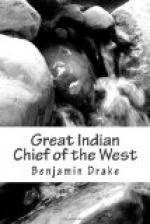of public sentiment, that little time was left for
Executive deliberation. Governor Reynolds issued
his proclamation, reiterating the dangers of the frontier,
and calling for a body of the militia to march and
protect it. A call under such circumstances was
promptly responded to, and in a short time, a large
body of mounted volunteers, embracing many of the most
respectable and influential citizens of Illinois,
were in the vicinity of the invading foe, and ready
for co-operation with the regular troops under General
Atkinson. A concentration of these two forces
was made at Dixon’s ferry, on Rock river, about
thirty miles below the encampment of Black Hawk and
his party. Had a conference now been sought with
the Indians, their prompt submission cannot be doubted.
Black Hawk, whatever might have been his previous
expectations, had received no addition of strength
from other tribes—he was almost destitute
of provisions—had committed no act of hostility
against the whites, and with all his women, children
and baggage, was in the vicinity of an army, principally
of mounted volunteers, many times greater than his
own band of braves. He would probably have been
glad of any reasonable pretext for retracing his precipitate
steps. Unfortunately no effort for a council was
made. A body of impetuous volunteers dashed on,
without caution or order, to Sycamore creek, within
three miles of the camp of a part of Black Hawk’s
party. He instantly sent a white flag to meet
them for the purpose of holding a council, and agreeing
to return to the west side of the Mississippi.
Unfortunately, for the cause of humanity, as well as
the good faith of the United States, this flag was
held to be but a decoy, and without waiting to ascertain
its true character, the bearers of it were fired upon
and one of them killed. An onset was immediately
made by Maj. Stillman upon Black Hawk, who finding
there was no alternative but war, met our troops,
and put them to flight in the manner already described.
Emboldened by his brilliant success in this engagement,
and finding that he would not be permitted to capitulate,
he sent out his war parties, removed his women and
children up Rock river, and a regular border war was
commenced. The murders which his men committed
upon the frontier settlers, naturally increased the
alarm throughout the state, additional volunteers
rushed to the seat of war, and the commanding General
commenced his military operations for a regular campaign.
In about two months, Black Hawk, having lost many
of his men, in the different skirmishes with the American
troops, and not a few of his women and children by
actual starvation, found himself upon the bank of
the Mississippi, endeavoring to escape the pursuing
enemy, by crossing to the west side of that stream.
While engaged in this act, the steam boat Warrior,
having an armed force on board, ascended the river
for the purpose of cutting off his retreat. Once
more Black Hawk raised the white flag, and sought




